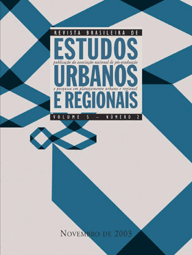Do Pruitt-Igoe ao World Trade Center: planejando a ex/implosão do (pós)modernismo
DOI:
https://doi.org/10.22296/2317-1529.2003v5n2p9Keywords:
arquitetura moderna, pós-modernidade, Pruitt-Igoe, World Trade Center.Abstract
O artigo discute, em meio a conceitos de pós-modernidade, as semelhanças na destruição de dois marcos da arquitetura moderna: o conjunto residencial Pruitt-Igoe (PI) e o World Trade Center (WTC). Argumenta que a destruição, tanto do PI como do WTC, deveu-se não apenas à questão física (no PI, uma destruição planejada pela sociedade, e no WTC, uma destruição por ela não planejada); pelo contrário, a queda de ambos os edifícios seria uma materialização do fim do pensamento modernista, do qual seriam símbolos. Contrariamente ao que foi dito a respeito do 11/09/2001, propõe que naquela hora o mundo já havia mudado e que a destruição do WTC foi apenas a representação da mudança. Seguindo essa argumentação, o artigo propõe inovações no campo do planejamento e da arquitetura, assim como novas concepções para espaços contemporâneos, a exemplo dos projetos do novo WTC.
Downloads
References
ANGOTTI, T. “Planning to rebuild: the issues ahead.” Planners Network, n.149(1), p.16-7, 2001.
ANNAN, K. “From Doha to Johannesburg by way of Monterrey: how to achieve, and sustain, development in the 21st century.” Palestra proferida na London School of Economics and Political Science. Londres, 25/2/2002.
ARCHITECTURAL RECORD. The Max Protetch Gallery Exhibit. “A New World Trade Center: Design Proposals”, mar. 2002.
BAUDRILLARD, J. The mirror of production. Saint Lois: Telos Press, 1975.
CASTELLS, M. “The world has changed: can planning change?” In: ACSP ANNUAL MEETING. 1990. Proceedings… Austin, Texas, 2/11/1990.
CRYPTOME. “Interesting comments on WTC Architecture and History.” Acesso em 2001 http://cryptome.org/wtc-collapse.htm
DALLMAYR, F. “Lessons of September 11.” Theory, Culture & Society: Explorations in Critical Social Science, v.19, issue 04, ago. 2002.
GAUSE, D. G.; LAWRENCE, B. “User-Driven Design: incorporating users into the requirements and design phase.” Acesso em: http://www.stickyminds.com/sitewide.asp?ObjectId=2659&Function=DETAILBROWSE&ObjectType=ART (Originamelmente publicado na revista STQE, jan./fev. 1999.)
GLANCEY, J. “Reaching for the sky: on the passion for tall buildings and what Tuesday’s events could mean for the future shape of our cities.” The Guardian, 15/9/2001. Acesso em http://www.guardian.co.uk/saturday_review/story/0,3605,552020,00.html
HARVEY, D. The condition of postmodernity. Oxford: Blackwell, 1989.
IRAZÁBAL, C. “Architecture and the production of postcard images: invocations of tradition vs. critical transnationalism in Curitiba.” In: ALSAYYAD, N. (Ed.). The end of tradition. Londres: Routledge, 2003.
JACOBS, J. M. “The global domestic: the highrise postcolonially considered.” CED – Architecture Lecture Series, University of California, Berkeley, 2000. (1 Videocassete, 76 min., VHS.)
JENCKS, C. El lenguaje de la arquitectura postmoderna. Barcelona: Editorial Gustavo Gili, 1981.
JENCKS, C. Late-Modern Architecture. Nova York: Rizzoli International Publications, 1980.
JENKS, H. “September 11. One year later: Mary Dudziak reflects on the transformative nature of 9/1/01.” El Boletín, Center for American Studies & Ethnicity and the Program in American Studies & Ethnicity, University of Southern California, 6, 2002.
LARA, F. “Depois do World Trade Center?” Vitruvius, 2001. Acesso em: www.vitruvius.com.br
LEY, D. “Postmodernity”. In: JOHNSTON, R.J. (Ed.). The Dictionary of Human Geography. 4.ed. Malden, MA: Blackwell Publishers, 2000. p.622-3.
LYNCH, K. “City and regional planning.” In: BANERJEE, T.; SOUTHWORTH, M. (Eds.). City sense and city design. Cambridge, MA: The MIT Press, 1973.
MACDONALD, D. Democratic Architecture: practical solutions to today’s housing crisis. Nova York: Whitney Library of Design/Watson-Guptill Publications, 1996.
MARCUSE, P. “Planning after September 11: the issues in New York.” Planners Network, n.150, p.36-9, 2002.
MARCUSE, P. “Urban life will change: proposals for rebuilding.” Planners Network, n.149(1), p.15-6, set./dez. 2001.
MUSCHAMP, H. “New Trade Center idea: move bulk to West St.” New York Times, 25/7/2002.
NEWMAN, O. Defensible space; crime prevention through urban design. Nova York: Macmillan, 1972.
SASSEN, S. “Governance hotspots: challenges we must confront in the post-September 11 World.” Theory, Culture & Society: Explorations in Critical Social Science, v.19, issue 04, ago. 2002.
SASSEN, S.; DORFMAN, A.; CHOMSKY, N.; EL SARRAJ, E.; RABIN, Y.; PLATKIN, D.; MOORE, M.; GALEANO, E. “The Seventh Generation.” Planners Network, n.149(1), p.18-20, 2001.
SCHOOL OF JOURNALISM AND THE CONGRESS FOR THE NEW URBANISM. “Rebuilding Lower Manhattan: A discussion.” The Terner Series on Urban Development, University of California at Berkeley, 26/9/2001.
SEGRE, R. “World Trade Center (1973-2001): fragilidade de um ícone urbano.” Vitruvius. Acesso em 2001 www.vitruvius.com.br
SIM, S. (Ed.). The Routledge Critical Dictionary of Postmodern Thought. Nova York: Routledge, 1999.
SPEAKS, M. “It’s out there: the formal limits of the American avant-garde.” Architectural Design, Londres, 68(5/6): 26-31, maio/jun. 1998.
WIKIPEDIA. “Minoru Yamasaki.” Acesso em 2001 http://www.wikipedia.com/wiki/Minoru_Yamasaki
WIKIPEDIA.“World Trade Center.” Acesso em 2001 http://www.wikipedia.com/wiki/World_Trade_Center
WISOTZKI, R. “Rafael Courtoisie busca una gran revelación en una página. A las torres de palabras no las derriba un avión.” El Nacional, Caracas, 24/11/2001.
Downloads
Published
How to Cite
Issue
Section
Categories
License
Copyright (c) 2017 Revista Brasileira de Estudos Urbanos e Regionais

This work is licensed under a Creative Commons Attribution 4.0 International License.
Authors who publish in this journal agree to the following terms:
1) Authors who publish in RBEUR retain the rights to their work and assign to the journal the right to first publication, performed under the Creative Commons Attribution License that allows work to be shared and assures the recognition of authorship and of the original publication vehicle, to RBEUR.
2) Authors are free to assume additional contracts separately, for publication and non-exclusive distribution of the version of the work published in this journal (e.g., publishing in an institutional repository or as a book chapter), reaffirming the authorship and recognition of the original publication vehicle, to RBEUR.











.png)

